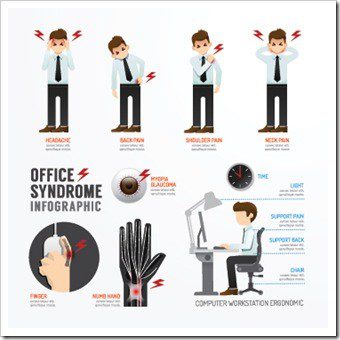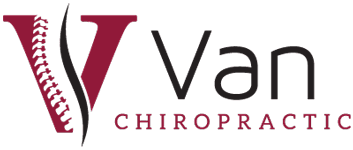 Gone are the days of sitting back in our office chairs with our feet on the desk. Now we have gone to the absolute other extreme to where our heads are almost in the computer screen as they are stretched and extended by our form that is becoming hunched and almost disfigured. With this wonderful posture we have gained illnesses and pains that could and can be avoided. To help find and create solutions to this growing trend and to help companies have healthier employees and in turn more productivity with less sick days, the science of workplace ergonomics was developed to address work place solutions which creates a win for both employee and employer.
Gone are the days of sitting back in our office chairs with our feet on the desk. Now we have gone to the absolute other extreme to where our heads are almost in the computer screen as they are stretched and extended by our form that is becoming hunched and almost disfigured. With this wonderful posture we have gained illnesses and pains that could and can be avoided. To help find and create solutions to this growing trend and to help companies have healthier employees and in turn more productivity with less sick days, the science of workplace ergonomics was developed to address work place solutions which creates a win for both employee and employer.
Simple Ergonomics
Ergonomics is the practice of suiting the conditions in which a person works to the specific capabilities and job demands of that employee. It follows that, for an ergonomic workplace to be created, a proper assessment of the environment must first of all take place so that appropriate changes can be made on the basis of accepted ergonomic principles. The aim is to create a safer and more productive working environment for the employee.
The Three Most Important Applications of Workplace Ergonomics:
- The stress of any lifting should be taken by the largest muscles to protect the smaller and more vulnerable ones.
- When working, the employee should be able to move comfortably between various correct postures so they don’t over-stress one particular part of the body for an extended period. Muscles become fatigued when kept tense for too long, especially if that one posture is poor.
- Joints should move through no more than 50% of their range when performing activities, and preferably be kept in a neutral position. Joints that are overextended can become damaged and susceptible to repetitive stress/strain injuries.
Tips for Safe Lifting:
When lifting anything off the floor, bend at the knees, not at the waist. Keep your head up, your neck and back straight, and use your leg muscles to power up to standing. Bending forward at the waist to lift brings your low-back muscles into it, and these can be easily pulled. Keep your elbows flexed and hold the object close in to your body to further minimize back strain.
Tips for the Desk Jockey:
- The height of the desk should be suited to your frame, and everything you need should be within easy reach.
- Your feet should be able to touch the floor, and the angle between your torso and thighs should be 90 to 110 degrees.
- Keep your body straight, head and neck upright, and keep your task directly in front of you. Don’t hunch or slouch.
- The top of your computer monitor should be at your eye level. Your head should be in a neutral position, otherwise any leaning forward can cause pain in the neck and head.
- Your wrists should be straight when typing, and your shoulders and forearms parallel to the floor.
- Anything you read at your desk should be at the same level as though you were reading it on your monitor. Use a book stand or a paper holder.
- Use a headset when talking on the telephone – certainly if you are doing so for long periods. Never use your shoulder to cradle the phone against your ear. This will lead to headaches and neck pain.
- Every 20 or 30 minutes, get up, have a stretch and go for a little wander. But do not stray to long.
- Frequently stretch out your neck, arms, wrists, back, and legs while working. Try neck rotations, fist clenches, arm dangles, and shoulder shrugs.
- Don’t stare at one thing for too long. If your eyes do not frequently shift focus, they will become strained. Take a few seconds to look from objects that are nearby to objects that are farther away, such as your colleagues who are still frowning at you following your last stretching routine.
Bonus Mouse Safety:
Use you arm and shoulder to move the mouse, not just your wrist. Hold the mouse loosely and keep your wrist straight and relaxed. The edge of your desk is not the best place to rest your wrist; instead, use a gel rest incorporated into the mouse mat. Take regular breaks during each hour to flex your wrists, and to move your arms and shoulders.
We Can Help!
With the exponential growth of the internet world our bodies can endure poor repetitive posture and strains for over eight hours a day and sometime more. These demands have developed many of these health challenges such as neck pain, headaches, low back pain, carpal tunnel.
As specialists our team has been developed to first address your pain symptoms but also work to create better solutions for you and your company’s team. We encourage questions and would love to help your team by helping you develop solutions to your work environment, which should be a happy healthy place for you; for you may be there more than your own home.
In Health,
Dr. Grey Gardner
